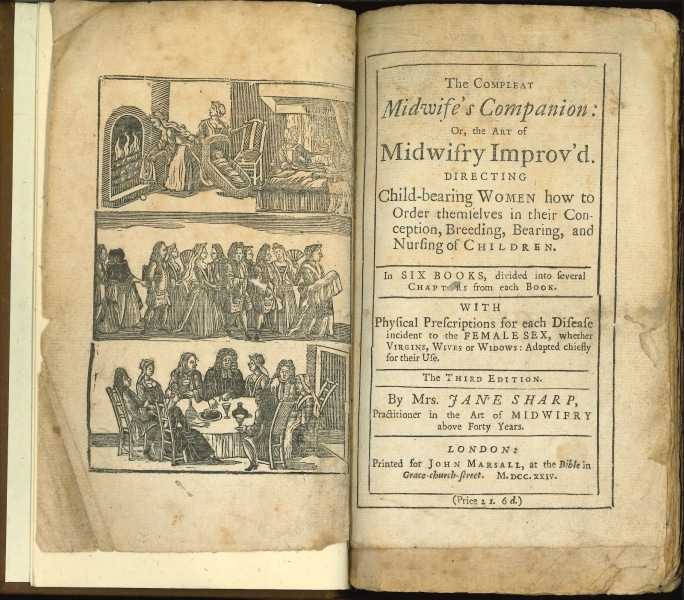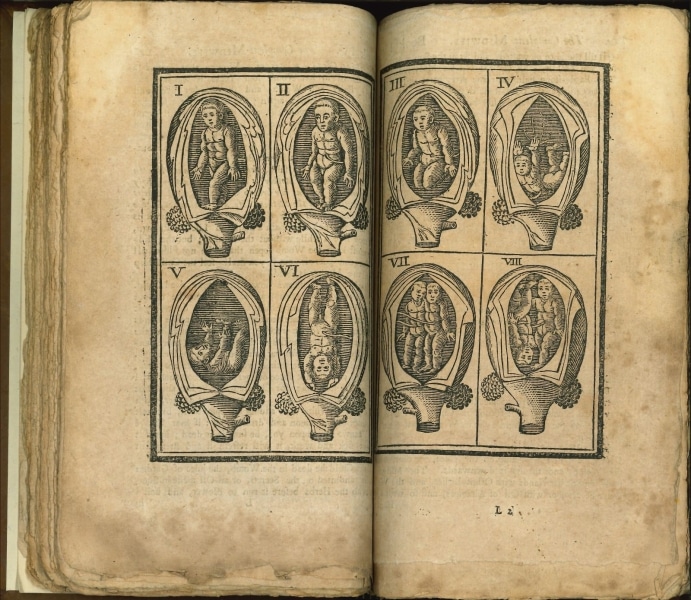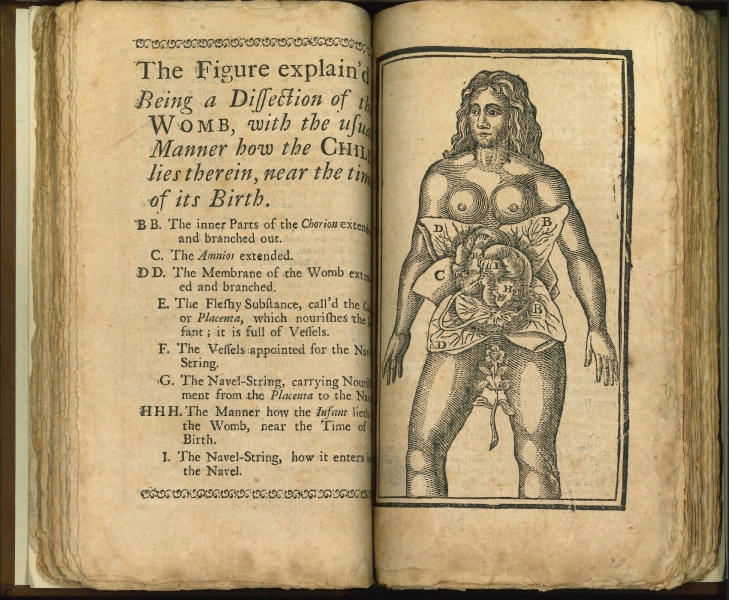Midwifery: A Historical Review of Shifting Approaches to Women’s Health
Lekha Doddamani, Friends Select School Senior Intern
In a two-week internship at the end of her senior year, Lekha Doddamani of Friends Select School examined a recent acquisition, perhaps the first English book about midwifery written by a woman, along with 19th- and 20th-century books on the subject. Lekha wrote this summary for us:
Jane Sharp’s The Compleat Midwife’s Companion, or, The Art of Midwifry Improv’d (London, 1724). Purchased with the Davida T. Deutsch Women’s History Fund.
In the 21st century, childbirth in America is often a hospital experience, requiring many medical professionals to assist the new mother. However, midwives were the primary childbirth professionals in the 17th century and long before. Jane Sharp, a 17th-century English midwife, put her knowledge on the page to educate women on the art of midwifery. Examining her book, Elaine Hobby’s edited version of the text, and other books, provides a window into ideas around women’s health issues in the past.
Often referenced in Jane Sharp’s book is humoral theory, an ancient system defining four main “humors” of the body: blood, phlegm, choler (yellow bile), and black choler (black bile). These humors indicated the balance of characteristics in a person, as well as their conditions of being hot, dry, cold, or moist. Humors would move around the body as a response to the needs of the organs, thought to each have their own “faculty”, or function (i.e. the heart’s pulsatile faculty caused it to beat, and the stomach’s attractive faculty caused it to attract food). Organs were thought to conduct a process of “transmutation”, or transforming one bodily fluid into another. This process occurred by the body heating the fluids into a new one, given that the fluid itself desired to be something new (organs were thought to agree with each other naturally). This explained why blood could be turned into breast milk in women, or semen in men.
According to humoral theory, it was a medical fact that men were superior to women because their humoral balance was much hotter and drier than women’s. Menstruation was a process women had to do to expel their bodies of excess humors because their cold bodies did not consume food as thoroughly as men’s. But women’s bodies being colder (and wetter) were better for conception, much as cool, wet environments were appropriate for the germination of seeds.
Jane Sharp’s The Midwives Book first appeared in 1671, with a third edition appearing in 1724 as The Compleat Midwife’s Companion, a copy of which is owned by the Library Company. During a time in which midwives were the usual birth attendants, Jane Sharp wrote the text for women. Midwifery had always been a woman’s role, as it was thought appropriate for only women to be witnessing childbirth. On its opening pages, Sharp has left a note to the “sisters” she wrote for.
Immediately what sticks out to the modern reader is the language Jane Sharp uses. The language of the text is reflective of the time Jane Sharp was writing in. Reading the book requires a lot of imagination, and an ability to decipher the book’s metaphoric language. Jane Sharp makes references to medical theories (humoral theory, particularly) and astrology to explain the natural occurrences of childbirth. What sounds fantastic to modern readers was the foundation to medicine in Sharp’s time. It is valuable to look back into history, to read how people understood the world around them. The conclusions may be unfamiliar (such as referring to the aorta as “the great artery”) but reveal a very different medical culture from ours.
Sharp also references astrological events, such as the full moon and the celestial zodiac, affecting the conception and birth of babies. The forces of nature were interpreted to have a deep impression on humankind, influencing all aspects of life. She writes, in the third edition of 1724:
“…but as the celestial bodies have their influence upon the terrestrial and upon all the elements, they cause all the changes here below, and are not changed themselves: for that the Heavens, and the fixed Stars, and the Planets, are still the same they were in the first creation, and that the twelve Signs and Planets do rule over the bodies of men and women…” (p. 90)
In modern science, referring to the patterns of the stars is considered pseudoscience. It is striking to see how much confidence Jane Sharp places on astrology and the influence of the stars on women’s lives.
Although the book was written for women, Jane Sharp included both men and women in her writing. The first few chapters are about the biology of both sexes, informing the audience the importance of both sexes in childbearing. As Jane Sharp states, “But to handle these things more particularly, Galen saith, that women have all the parts of Generation that men have, but mens are outwardly, womens inwardly.” (p. 34) Jane Sharp was remarkable for her time, a woman writing for other women. She accomplished putting first-hand experience into writing to support fellow women.
Jumping ahead to the 1870s we see a very different approach to midwifery. For a book about midwifery written by Joseph Griffiths Swayne in 1873, the intended audience of the book seems to be male medical students. In Obstetric Aphorisms (Philadelphia, 1873) the first notable thing is that it completely skips over the parts about male and female anatomy, jumping into the process of labor from the beginning. This 1873 book also makes the assumption that only men will read it, and perhaps it is more readable for that audience by using newer medical terminology. However, it seems that Sharp’s book was also targeted to an audience of common women, wives, mothers, daughters, sisters, etc. A large aspect of midwifery that is not acknowledged in professional medicine is comfort and care. Midwives act as caretakers for the pregnant women throughout the process of childbearing. Jane Sharp must have had that in mind when writing her book, explaining in detail the roles of men and women, and the care necessary before and after the birth of the baby.
Illustration from Jane Sharp’s The Compleat Midwife’s Companion (London, 1724).
Another book from 1873 was by an American female author, E.B. Duffey, called What Women Should Know (Philadelphia, 1873). A distant predecessor to the modern feminist literature of the 1970s and 80s, the book is less about midwifery and more about the empowerment of women. This book is a great early example of pro-women’s health education. Mrs. Duffey writes, “To the wives and mothers of America…That it may especially aid and inspire them to become truer and nobler women, physically, mentally and morally, and more worthy representatives of the age in which we live.” (p. 5) The book is targeted at women, and the language of the book is much less technical than Jane Sharp’s or that of Joseph Griffiths Swayne. Perhaps it was reinforcing sexist stereotypes, that women could not be educated and therefore could not understand the terminology used in the other books, but the book teaches women about themselves in simpler language.
Writing about the shift from woman midwives to men midwives, Jane B. Donegan grapples with the intertwined relationship between sexism and midwifery in America in her Women and Men Midwives (Westport, Conn., 1978). Midwives in colonial America received their training in Anglo-American practices. Over time, the expansion of formal medical training pushed men into the new field of obstetrics, thus breaking down the long-standing tradition of female midwives, who provided comfort to the new mothers. There was a lot more professionalism available to men at the time, who performed in medical jobs like doctors, surgeons, and apothecaries. It was extremely difficult in London for women to be recognized on a professional level like men, and there were very few instructional manuals for them to read, so all of their knowledge was gained through observation. Even when midwives could become officially recognized and licensed in England, men became preferable for their professional education. “Although the individual items in the oath may be indicative of widespread abuses, it is not possible to determine accurately how much obstetrical skill these early midwives possessed. The testimonials and licenses suggest that many women gained experience by practicing midwifery unlicensed for years.” (p. 13)
As Donegan remarks, “Eighteenth-century English women and Englishmen alike, irrespective of class, accepted a male-defined view of women that held that however capable they might be in certain prescribed areas, women were neither emotionally, physically, nor intellectually suited to the discipline required in protracted formal study.” (p. 20). In the early 1800s, midwives were starting to lose their appeal in America due to the efficiency of the obstetricians. They had access to tools like forceps, and provided the possibility for a quicker, safer delivery. The shift from midwifery to obstetrics caused a lot of tension between the two groups.
However, preference for the male obstetricians who were not trained through experience like the midwives of old soon lessened. The men made mistakes using tools like forceps during labor, which often made for a hasty delivery rather than a safe one. Midwives, historically, provided a lot of comfort for the women in labor whereas the new doctors were more focused on the performance of the surgery. This meant that unnecessary use of tools were harmful to the women, and did not help them to emotionally and mentally get through the birth. Jane Sharp rarely references the use of tools other than one’s own two hands, contributing to the argument that women should be the front and center of childbirth because they understand what is biologically occurring better than the male doctors.
In the 19th-century, there was some resistance to man-midwives in some circles. As men had to perform check ups on married women, it was deemed “improper” and against the morals of 19th-century American society. The use of tools resulted in many infant deaths, unlike the practice of midwives who only called for the use of tools in emergency situations. The situation resurrected the female midwifery industry, with women’s medical colleges opening up to educate women in the ways of surgery and midwifery through formal education. It is interesting to read about the back and forth between men and women in the midwifery field, but it does not completely take into account the details of knowledge. Jane Sharp’s style of midwifery paralleled her time, but much of her instruction holds true to childbirth today, challenging the notion that there is always a call for emergency in labor. Jane Sharp understood that women knew what they were doing, and that they had to put faith into each other and their bodies to do its purpose.
The general feminist tone of women’s health and history books in the 1970s is a dramatic shift from the midwifery books of the 1700-1800s, but they provide an interesting counterpoint to Jane Sharp’s 17th-century text. Our Bodies, Ourselves (1973) by the Boston Women’s Health Book Collective might be another form of Jane Sharp’s book. It too is “written by and for women” and discusses topics ranging from biology to self expression.
Many parts of the book around childbearing are different from Jane Sharp’s, however. With sections about birth control, the decision to have children, in addition to the process of childbirth and anatomy, Our Bodies, Ourselves feels much more accessible to the modern reader. “Most of us could very easily give birth with the experience and help of a trained midwife, either in a hospital, a special maternity house, or at home among family and friends.”(p. 157) However, the overall feeling of comfort and familiarity with women mirrors Jane Sharp’s book. While the Midwives Book seems very outdated, it has an undeniable sense of familiarity and trust between Sharp and her audience. The informal “we” and “you” in Our Bodies, Ourselves alludes to that same sense of community among women.
Although Our Bodies, Ourselves is not only about midwifery, there is a lot of information targeting women of childbearing age. It explains pregnancy to women and what they need to be aware of during labor, as Jane Sharp’s text does. However, in the 20th century, there is a decision to be made between at home delivery and hospital delivery.
Despite its age, Jane Sharp’s The Compleat Midwife’s Companion is a fantastic read, and provides insight into women’s central role in helping women understand their bodies and the process of giving birth before the rise of modern medicine.
Books examined:
Boston Women’s Health Book Collective, Our Bodies, Ourselves (New York, 1973).
Donegan, Jane B., Women & Men Midwives: Medicine, Morality, and Misogyny in Early America (Westport, Conn., 1978).
Duffey, Eliza Bisbee, What Women Should Know: A Woman’s Book about Women (Philadelphia, 1873).
Sharp, Jane, Mrs., The Compleat Midwife’s Companion, or, The Art of Midwifery Improv’d (London, 1724).
Sharp, Jane, Mrs., The Midwives Book, or, The Whole Art of Midwifry Discovered (New York, 1999). Facsimile reprint of the first edition of 1671, with an introduction by Elaine Hobby.
Swayne, Joseph Griffiths, Obstetric Aphorisms: For the Use of Students Commencing Midwifry Practice (Philadelphia, 1873).
Thanks, too, for the feedback from Mary Fissell, author of Vernacular Bodies: The Politics of Reproduction in Early Modern England (Oxford University Press, 2004).





